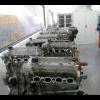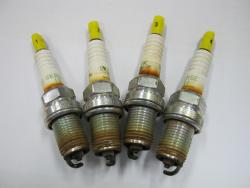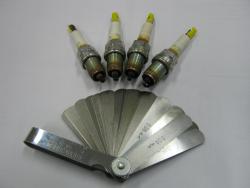Search the Community
Showing results for tags 'spark'.
-
Hi all, i remember reading somewhere here that one workshop can change spark plugs for a low price but tried searching for it to no avail. i will provide my own spark plugs but any recommendations as to where to change it as it is too expensive in autobacs.
-
Aftermarket vs. OEM Spark Plug Wires One of the most hotly debated topics in tuning Hondas is the perceived benefits of aftermarket spark-plug cables. These are often marketed with the promise of 'better' and 'more powerful' sparks and thus directly inferring better combustion and a gain in power output. Armchair 'tuning specialists', enthusiasts, and even mechanics alike have discussed about the supposed mediocre sparking qualities of the stock Honda spark-plug cables and, especially at high RPMs typical when revving VTEC Hondas, how the stock cables will be struggling to produce good consistent sparks. Aftermarket cables comes into the picture claiming to produce better, 'larger' and more consistent sparks at high RPMs and therefore higher power output. How true are these claims ? To clear the mystery and resolve this debate once and for all, TOVA requested Dynojet Far East to perform a spark-plug cables dyno test. The car used is a JDM Honda Integra XSi with the B16A engine. The stock plug cable has been in use for the better part of 8 years. At this age, many will begin recommending their replacement by aftermarket cables, often citing that they will be worn out and thus not giving good sparks. The car has been regularly serviced (either 5000km or 3 months whichever expires first) using original Honda oil filter and Mobil-1 synthetic engine oil. At the time of the test, all maintenance items are new; spark plugs, HKS Super-Power-Flow filter element, even gear oil (using Honda recommended oil). The fuel injectors have also been cleaned less than 4 months ago. The car has also just benefited from the fitament of brand new HKS Legal Muffler and HKS Super-Header, with a HKS AFR to re-calibrate the air-fuel ratio to our local atmospheric conditions. Aftermarket cable number 1 represents the generic 8mm silicon 'high performance' replacement cables. Often these cables are marketed by performing a side-by-side comparison on a special setup where first the stock cable are used to connect a spark-plug to an ignition coil. The sparks produced at the plug will be seen to be weak and dull. Next, replacement of the 8mm silicon cable will be done and now the sparks at the plug can clearly be seen to be bright and strong. From this 'conclusive' demonstration, the benefits to power output will be inferred. I will not be embarrassed to admit that I myself have bought three sets of such cables in my earlier Honda ownership days (when I was driving SOHC engine models), often being conclusively convinced by the demonstration and then actually believing that I felt improvements from the cables. I have owned this cable for about 5 years, using them on and off. Aftermarket cable number 2 is the famous NGK 'blue' cable, ie NGK Hyper Silicon. Having the same diameter as stock cables (and thus the added advantage of direct replacement), the NGK is a cable that even HKS has recommended over stock. The logic given was often that the NGK will last longer than stock as well as the typical giving 'better' spark benefits. In fact, the box that the NGK comes in has a claim of 130% better sparks - hence more power from the engine. The NGK cables are brand new, and supplied by Dynojet Far East to help settle the debate. The dyno runs were performed immediately one after the other, with only the minimum of delay necessitated by having to switch off the engine to replace the plug cables. To get straight to the point, the three dyno runs are produced below. The power curves are: green is for the stock cable, red for the generic 8mm silicon, and blue for the NGK blue cable. The actual power outputs are not crucial and have been removed from the charts to make the comparison more straightforward. The most important point from the charts is that the stock spark-plug cables produced the highest and most consistent power curve. The most significant factor is the smoothness of the stock cable's power curve. Both the 'generic' 8mm silicon cable and the NGK were seen to be misfiring as evidenced by their jagged curves after 5000rpm and especially in the VTEC rpm band. Both 8mm silicon and NGK delivered about the same max power which is about 1ps lower than that produced by the stock cables. Note that the stock cables, although 8 years old, consistently produced better power all across the dynoed rpm band, 3000rpm till the 8000rpm red-line. Especially surprising is the fact that the stock cables did not misfire, thus proving that they produce more consistent sparks even compared to the brand new and supposedly superior NGK blue cables ! The results although probably shocking to many enthusiasts are in fact what have often been recommended by the best tuners. Many enthusiasts naturally are reluctant to accept the fact, no matter how highly they respect those tuners but with this comparison, TOVA hopes that the question have been conclusively answered and the debates are now closed. Stock spark-plug cables are the best ! Copyright Wong KN Temple of VTEC Asia Feb 01 1999.
- 58 replies
-
- Aftermarket
- Spark
-
(and 2 more)
Tagged with:
-
Hi any one here change your own spark plugs?? how to judge to tighnest of the spark plugs??
-
Does anyone know where is the best rate to change to IK20? 1)Stamford tyres charge $80/4 pieces (Including labour) 2) Auotbac charge $78/4 pieces (Not including labour. Quoted $5 for normal car) So any Bro have gd lobang?? Cheers
-
Just bought a Mazda 5 SP 2008. Looking to replace the spark plugs but it seems that there is some with 18mm reach and some with 25mm reach. Like to seek advice on which is the correct ones to use. Thanks in advance
-
Hi Everyone, Anyone driving Latio/Sylphy1.5 who has use Lotus Long Life Spark Plug please provide your feedback. Went for servicing and W/S recommended Lotus Spark Plug instead of the Denso Iridium spark plug. Cost is only 1/3 of the Denso Iridium but I am seeking feedback from anyone whom have use or heard of this Lotus Spark Plug before please any feedback is welcome. Thanks
- 33 replies
-
- 1
-

-
- nissan
- maintenance
-
(and 6 more)
Tagged with:
-
Was troubleshooting a car for online test and it was supposed to be an EGR only fault. However after replacing EGR it was unable to start. I checked battery, had it jumpstarted in case of low voltage, checked fuel pump,ignition coil, almost every part of the engine. Spark plug was clean and there was no function to test if it was okay or dtc like engine misfire. All was ok. But car still unable to start. So i failed. Only when time elapsed and teacher finish the test did i see spark plug fouled. Which was kinda strange as there was no dtc relating to cylinder misfire Can't be so fast fouled up? Really sian especially as it was just an EGR fault and i replaced the correct component but i missed out on something important.
-
During the last servicing, I request for a full servicing since immediately i got my 2nd hand car. I requested for a Denso iridium but it turn out to have a NGK copper plug installed inside. Fine... little did i realise the spec for the plug is a bit off in the spark position parameters. Its +1mm more. I always wondered why my car got this weird pulsing engine vibrating where it thud harder than usual. After changing to the correct spec denso spark plug, I can feel a bit of HP increase and also the weird pulsing vibrating is gone. Morale of the story, always check what your workshop have done to your car.
-
dear brothers/sisters, anyone can advice how to remove spark plug that is stuck to the car? mechanic managed to remove 3 out of 4. now left one and the mechanic say its dangerous to remove, might result in engine need to be removed. google and found some results like spraying WD40 or on the engine make it warm then easier to remove. thanks in advance for any advice given!
- 17 replies
-
- spark plug
- remove
-
(and 4 more)
Tagged with:
-
Hi guys, i brought the wrong NGK Iridium spark plug model for my Honda civic EK SiR B-series model. Will i damage the engine or cause any problems to it? After i had changed, i kinda smell some sort of buring smell inside my car. I'm quite worried is it the cause of wrong model of spark plug i brought? I brought ZFR6FIX-11 instead of BKR6E-N-11..
-
I installed a multi spark discharge on my A6, and it works perfectly, but one of my friends told me that it will lead side-effect to my car. I dont meet any problem till now. Any bro can give advice?
-
Lesson 101 for Driver. The spark plug's location exposes it to extreme temperature variations, chemicals, fuels and oils. It is also attacked by cylinder pressures produced by the piston and cam timing, then it is also assaulted by high-output ignition units. As a result of all of this, one can effectively learn what the engine is doing by reading the firing end of the spark plugs. By careful examination of the plug's color, gap, and any deposits that reside on it, you will be shown the efficiencies as well as deficiencies of what is going on in the engine. Spark plugs should be checked at least yearly, and replaced as often as necessary. In most cases you can follow the manufacturers recommendations for replacement intervals. How a Spark Plug Works: The basics of a spark plug is that it must perform two primary functions. To Ignite the Air/Fuel mixture To REMOVE the heat out of the combustion chamber Spark plugs transmit electrical energy that turns fuel into working energy. A sufficient amount of voltage must be supplied by the ignition system to cause the spark to jump the across the spark plug gap, thus creating what is called Electrical Performance. Additionally, the temperature of the spark plug's firing end must be kept low enough to prevent pre-ignition, but high enough to prevent fouling. This is called Thermal Performance and is determined by the heat range of the spark plug. It is important to understand that spark plugs CANNOT create heat, only remove it! The spark plug works as a heat exchanger, pulling unwanted thermal energy away from the combustion chamber and transferring the heat to the engine's cooling system. The heat range is defined as a plug's ability to dissipate heat. The rate of heat is determined by: The insulator nose length Gas volume around the insulator nose Materials and/or construction of the center electrode and porcelain insulator Now to the actual function: As the Ignition is triggered it sends the spark through the rotor, to the cap, down the wire and then it jumps the gap of the spark plug, a spark kernel is created that ignites the air/fuel mixture in the combustion chamber. Proper timing of this spark is not the only concern as described above. You must have the proper heat range as well as the correct gap. Opening The Plug Gap: On weaker or stock ignitions, opening up the gap CAN increase the spark kernel size, thereby creating a more efficient burn. The problem lies in that any added gap creates more strain on the other ignition parts. Coils may not have enough stored energy to fire, or in the least case, not enough energy to cross the gap, creating a miss-fire. Plug wires will break down due to the added resistance as the spark tries to reach ground. Rotor and Cap, as well as points (if you still have an interest in prehistoric ignitions), and the carbon bushing in the center of the distributor cap will show early failures. All of this is because the greater the gap and the higher the voltage requirement to jump the gap. Do not forget the gap between the rotor arm to the distributor cap too. A high performance rotor is a bit longer at the tip, allowing less spark loss or chance of spark scatter in the cap as the spark attempts to jump the plug gap. It is also possible to slow down a car if the gap is too big. Spark Plug Heat Range: A spark plug's heat range has no relationship on the actual voltage transferred through the spark plug. Rather, the heat range is a measure of the spark plug's ability to remove heat from the combustion chamber. The heat range measurement is determined by several factors: The length of the ceramic center insulator nose The insulator nose's ability to absorb and transfer combustion heat The material composition of the insulator The material composition of the center electrode The longer the insulator nose gives you a larger surface area exposed to combustion gasses and heat is dissipated slowly. This also means the firing end heats up more quickly. We are talking about exposed ceramic length, not extended tip length. The insulator nose length is the distance from the firing tip of the insulator to the point where the insulator meets the metal shell. Since the insulator tip is the hottest part of the spark plug, the tip temperature is a primary factor in pre-ignition and fouling.The spark plug tip temperature must remain between 450
-
Hi all, This is an update further to my post on NGK BKR6E-11 (a.k.a V-Power) condition at 30k km usage. Ref: http://www.mycarforum.com/index.php?showto...spark*&st=0 Recently I just changed out this new sets of "Copper" spark plug (NGK BKR6E-11) with 40,000 km usage. Price for each spark plug is only S$3.50 and it can last 40km without symptom of mis-firing, difficulties in starting, etc. I only felt acceleration a bit sluggish at it approaches 40k km. Below is the photos of the 4nos spark plugs. I took the gap measurement using feeler gauge. According to specifiction, brand new NGK BKR6E-11 the gap should be 1.1 mm. Photo of No.1 cylinder spark plug is below, and the gap measured is 1.18 mm Photo of No.2 cylinder spark plug is below, and the gap measured is 1.19 mm Photo of No.3 cylinder spark plug is below, and the gap measured is 1.18 mm Photo of No.4 cylinder spark plug is below, and the gap measured is 1.20 mm I visually inspected the tips using 10x magnifier, and noticed that No.1 ~ No.3 spark plugs the edge of the tips looks slightly rounded. No.4 spark plug tip looks the least rounded but gap is the biggest. Grounding condition looks less deteriorated than the tips for all the spark plugs. Conclusion: normal "copper" spark plugs can go 30,000 km on my engine without any issues, but to take it to 40,000 km is a bit pushing it. I think 30k km is the limit for my car.
-
I cross-reference BKR6E-11 on www.sparkplugs.co.uk and this is what I get: NGK BKR6E-11 (standard) Denso IK20 (Ir centre) NGK BKR6EP-11 (Pt tipped centre) Denso PK20PR-P11 (double Pt) Denso PK20TR-11 (2 ground electrodes) NGK BKR6EIX-11 (Ir centre) Denso PK20PR-11 (Pt tipped centre) Denso K20PR-L11 (special design) Denso K20PR-U11 (standard) Champion 2071 (premium Au plug) Champion 7071 (double Pt) Champion 3071 (Pt tipped centre) Champion 318 (standard) Splitfire SF392C (standard) Splitfire TP392C (triple Pt) IMHO pure marketing BS Bosch 4418 (Pt +4) again marketing BS Bosch 7557 (standard) Bosch 4301 (Pt 2) Bosch 4202 (I think Pt tipped) FR8DCX (standard) FR8DPX (Pt plug)
-
Hi Guys, I'm looking for a replacement spark plugs for my Toyota Fielder. Original plug was Denso's FK16HR11. I've checked the stockists and found that they don't carry this but do have other Iridiums/Platinums for replacement. Some of them carry FK20HR11 which I found that was the standard part for 2006-2007 Axio/Fielders. But since 2007 onwards, Toyota fitted FK16HR11 in new deliveries. I've checked the Denso catalogue for spark plugs and I didn't find the normal copper plugs equivalent. Has anyone replaced the plugs on a axio/fielder with a copper one?
-
TORQUE WRENCH and gapping tool? and how much?
-
Pls advise what is the "intake side of the cylinder head"? Can I request the mechanic to install the spark plug accordingly during servicing? The next time you are doing a tune-up on your ride, be sure to take note of this modification. By simply installing your plugs in a particular way, you will pick up roughly 1 whp, dyno proven time and time again. Index your spark plugs - The idea here is to "aim" the open end of the spark plug terminal (the gap) towards the intake side of the cylinder head. In order to accomplish this, simply mark on the plug a small line to indicate where this gap is. Proceed to install them as you normally would, except when the plug is hand-tight (that is, you've screwed it in without a ratchet as far as it'll go), use your ratchet to tighten the plug until the open end of the plug, faces the intake side of your cylinder head. Try to line up as best as you can. It may require buying 2 sets of spark plugs in order to do this, but hopefully you'll be able to do this the first time. Be careful with aluminum heads not to over tighten, as that could lead to a costly repair. That's it!
-
Hi guys, I was on leave today so went Jalan Jalan around some of the car workshops. I was in this workshop and was contemplating on where to change my current stock spark plugs to the Denso Iridium one. I asked one of the guys in the workshop of which Denso spark plug can the Optra use and he told me can use the IK16 one. I asked him about the IK20 one and he told me IK20 for above 1.6L car and IK16 for 1.6L and below car. I am not sure if he is right or not. Anyone can shed some light on this matter? Also, between Denso and NGK iridium spark plug which is better?
-
Hi bros, not sure if any one has encounter with oily spark plugs.. i pull out the injectors and plugs, they are all oily instead of dry.. must be a leak defintely somewhere.. pls advice on the needed replacement parts to get from stockist :)
-
y as above? any cheaper replacement for the above? the guy quote me 40~50 a piece and they r 6 pieces all together....
-
My friend asked me why his Camry spark plugs has some oil. His car seems to be eating oil. I believe some seals are leaking. What do u thinking is the problem and cost of repair?
-
Hi All, Went for 40K servicing on my Honda Fit (year 2008-2009) today. Was told that the new Honda fit uses 4 x Spark Plug and can last 100k Is this correct?
-
Hey peeps, Does anyone know whether the 1.3 2008 Fit comes with iridium spark as stock? Cos that is what i read off the internet. It say SKJ20DR-M13 which has 60000 miles lifespan. If so then it is still early for plug change for me. Cheers.















